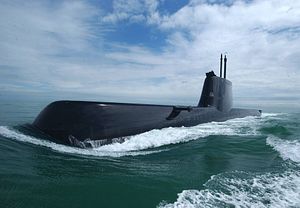South Korean defense contractor Daewoo Shipbuilding and Marine Engineering (DSME) has launched the Republic of Korea Navy’s (ROKN) eighth Son Won II-class (Type 214) diesel-electric air-independent propulsion (AIP) submarine, DSME announced on November 8.
The launch ceremony of South Korea’s latest sub, the Lee Beom-seok — a domestic license-built variant of the Type 214 submarine build by Howaldtswerke-Deutsche Werft of Germany — took place at the Okpo shipyard shipyard in Geoje Island, in the southeastern part of South Korea. The new submarine is expected to be commissioned by the end of 2018 following extensive builder and operational trials.
The Lee Beom-seok is the third submarine of the Son Won II-class (also known as KSS 2-class) assembled by DSME. As I reported elsewhere (See: “South Korea Launches New Stealth Submarine”), another South Korean defense contractor, Hyundai Heavy Industries (HHI), has launched another five Son Won II-class subs over the last years. The latest boat built by HHI, the Hong Beom-do, was launched in April and is expected to be delivered to the ROKN after extensive operational trials in July 2017.
As I summarized previously:
The recent launch is part of a three-phased naval construction program to build up the ROKN attack submarine force. South Korea currently operates a fleet of nine 1,200-ton Chang Bogo-class diesel-electric attack submarines – a variant of the German Type 209 boat. Under the first phase, the ROKN is planning to upgrade all nine Chang Bogo-class submarines with air-independent propulsion and flank-array sonars over the next few years.
The nine Son Won II-class vessels are part of the second phase of the ROKN’s so-called Korean Attack Submarine program. The third and final phase (and also the most ambitious part of the project) will be the construction of nine indigenously produced 3,000-ton diesel-electric attack submarines – designated KSS-III – equipped with air-independent propulsion and multiple vertical launch tubes from which Hyunmoo-3C cruise missiles with a range of up to 1,500 kilometers can be fired.
South Korea is also currently in the process of developing a new submarine-launched ballistic missile (SLBM) for the KSS-III–class. Although not officially confirmed, the new missile will likely be a variant of the Hyunmoo-2B or the Hyunmoo-2A, as I reported previously. “Two Hyunmoo-2B (현무, literally means “Guardian of the Northern Sky”) prototypes were test-fired in June 2015. The ballistic missile purportedly has a range of more than 310 miles and can carry a payload of up to 2,200 pounds (997 kilograms). It is capable of hitting targets anywhere in North Korea,” I summarized (See: “South Korea to Develop Submarine-Launched Ballistic Missile”).
The new 1,800-ton submarine measures 65 meters (213 feet) in length with a beam of seven meters (22 feet). “With its air-independent propulsion system, built around Siemens polymer electrolytic membrane fuel cells, the submarine can stay submerged for up to two weeks and can dive up to 400 meters (1,312 feet) deep,” I reported elsewhere. Powered by two MTU Friedrichshafen diesel engines, the Lee Beom-seok is capable of reaching a top surface speed of 12 knots and up to 20 knots when submerged with its electric motor. The sub can be armed with long-range submarine-to-ground cruise missiles, anti-ship cruise missiles, heavyweight anti-ship torpedoes, and naval mines.






























